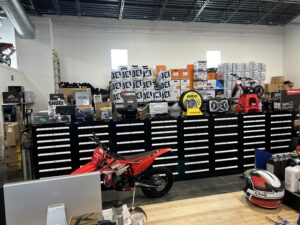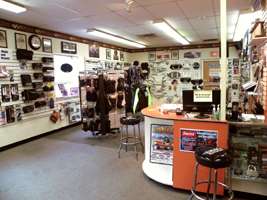Your Go-To Motorbike Shop for Quality Parts and Accessories
Your Go-To Motorbike Shop for Quality Parts and Accessories
Blog Article
Comprehending the Crucial Parts of a Bike: A Comprehensive Guide for Fanatics
For motorcycle fanatics looking to boost their riding experience and ensure their bikes run smoothly, recognizing the vital parts of a motorbike is extremely important. Each aspect, from the engine's intricate operations to the important duty of the braking devices, not only influences performance however likewise safety and security and comfort. This guide will certainly go through the fundamental components that every biker should be acquainted with, making it possible for educated choices in both upkeep and possible upgrades. As we start this expedition, one must ask: how does each component engage to develop the smooth ride every enthusiast seeks?
Engine Components

The camshaft plays an essential duty in managing the timing of the engine's valves, making certain the exact opening and closing required for reliable fuel and air consumption, along with exhaust expulsion. This timing is critical to keeping ideal engine performance and efficiency. Furthermore, the carburetor or gas shot system, depending upon the motorbike design, is accountable for mixing air with fuel in the right ratio for combustion.
The air conditioning system, either air or liquid-based, works to preserve the engine's temperature level within operational limitations, preventing overheating and guaranteeing longevity - motorcycle shop. Each element, diligently developed and incorporated, adds to the smooth operation of the engine, specifying the motorcycle's power outcome and overall efficiency
Transmission System
Integral to the motorbike's functionality, the transmission system makes sure efficient power transfer from the engine to the wheels. This system consists of a number of vital components, including the clutch, gearbox, and final drive, each playing a crucial duty in converting the engine's power right into activity. The clutch, commonly run by a hand bar, offers to disengage the engine and involve from the transmission, permitting smooth equipment adjustments and regulated velocity.
The transmission, typically described as the transmission correct, contains a set of equipments that motorcyclists can by hand change via to readjust the bike's speed and torque outcome. These gears are arranged in a series that makes it possible for the bike to increase efficiently and preserve ideal engine efficiency across different speeds. Many motorcycles use a sequential gearbox, needing the rider to shift gears in a predetermined order.
Braking Mechanisms
While understanding the transmission system is essential to utilizing a motorbike's power, similarly vital is the ability to regulate and stop that power effectively, which is where stopping devices enter into play. Brakes are critical for safety and security and efficiency, giving the rider with the required control to navigate various surfaces and problems. Generally, motorbikes feature 2 kinds of stopping systems: disc brakes and drum brakes.
Disc brakes are a lot more prevalent in modern-day motorcycles as a result of their exceptional efficiency. They include a brake disc, caliper, and pads. When turned on, the caliper squeezes the brake pads versus the rotating disc, converting kinetic power into warmth, thus slowing the wheel. This system supplies much better warmth dissipation, constant efficiency, and enhanced stopping power, especially in wet problems.
On the other hand, drum brakes, though much less common, are still discovered in some bikes. They function by pressing brake shoes versus the internal surface of a drum connected to the wheel. While typically much less efficient in heat dissipation and quiting power, drum brakes are simpler and much more economical.
Comprehending these informative post braking systems' nuances allows bikers to preserve their bikes properly and appreciate the engineering that makes sure secure and efficient stopping.
Suspension and Steering
Suspension and guiding systems are vital parts that substantially affect a bike's handling and ride comfort. The suspension system, consisting of forks at the front and shock absorbers at the rear, takes in road irregularities, enhancing stability and he has a good point control. Front forks, upside down or commonly telescopic, compress and rebound to minimize influences, while back shock absorbers keep tire call with the roadway, vital for grip and safety.
Steering, focused around the handlebars, attaches the rider to the motorcycle's directional control. The steering head bearings guarantee smooth operation, permitting exact ability to move. Proper positioning and upkeep of these bearings are critical for predictable guiding feedback and decreasing motorcyclist tiredness.
The suspension's adjustability is one more important element; preload, damping, and rebound settings enable personalization to suit various riding problems and styles. This flexibility is important for optimizing performance, whether navigating urban streets or tackling tough routes. Advancements like digital suspension systems offer real-time changes, improving trip top quality across varied terrains.

Electrical Equipments
After guaranteeing a controlled and smooth adventure through reliable suspension and steering systems, interest transforms to the electrical systems, a crucial element of modern-day motorcycles. These systems play a critical duty not only in beginning the engine yet also in powering numerous parts that enhance the performance and safety of the motorbike.
At the heart of a motorbike's electric system is the battery, which stores electrical power essential for starting the engine and powering complementary systems - motorcycle shop. The alternator or generator, combined with the rectifier-regulator, makes certain the battery remains charged while the motorbike is in operation, converting mechanical power right into electric energy and preserving voltage degrees
The ignition system, an additional vital part, is liable for igniting the air-fuel mix in the engine's cylinders. Modern motorbikes usually utilize a digital ignition system, offering greater efficiency and reliability compared to typical systems.
Lighting systems, including headlights, tail lights, and indicators, are also vital, making sure exposure and security for the motorcyclist. Extra digital parts such as sensing units, control devices, and shows add to innovative attributes like gas shot administration, anti-lock braking systems (ABDOMINAL), and electronic dashboards, even more improving the riding experience.
Conclusion
A detailed understanding of a motorbike's vital elements, including the engine, transmission system, braking mechanisms, suspension, guiding, and electric systems, is important for lovers aiming to optimize security, performance, and comfort. Proficiency of these elements permits educated choices concerning maintenance and upgrades, eventually improving the riding experience. By integrating this expertise, bikers can guarantee their motorcycles operate at peak performance and reliability, consequently making best use of both pleasure and long life of their vehicles.
For motorbike lovers looking to boost their riding experience and ensure their bikes run smoothly, Bonuses comprehending the important elements of a bike is paramount.Essential to the motorbike's capability, the transmission system ensures effective power transfer from the engine to the wheels.While comprehending the transmission system is vital to utilizing a motorbike's power, similarly vital is the ability to control and stop that power efficiently, which is where stopping systems come right into play. Commonly, bikes include 2 kinds of stopping systems: disc brakes and drum brakes.
A comprehensive comprehension of a motorbike's vital elements, including the engine, transmission system, braking systems, suspension, steering, and electrical systems, is essential for lovers aiming to optimize performance, safety, and comfort.
Report this page